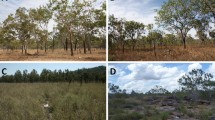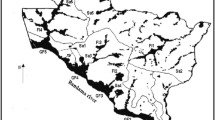Summary
The development of the ant communities and their foraging dynamics were studied in two annual agroecosystems of the Mexican tropical lowlands: a “forest milpa” of corn, beans, and squash made by cutting and buring 40-year-old forest, and a “field milpa” of corn, beans, and squash made by plowing 1-year-old second growth. The ant community was sampled using tuna fish baits 26, 52, 110 and 353 days after planting. Although immediately after planting the same number of ant species occurred in each milpa type, thereafter the ant faunas diverged. The field milpa became completely dominated by the native fire ant, Solenopsis geminata, while the number of ant species in the forest milpa gradually increased over time, reaching eight species 110 days after planting and 14 species by 353 days. Initially S. geminata dominated the ant fauna in the forest milpa (occurring on 90% of the baits), but by 353 days planting it was found on only 26% of the occupied baits. Ant foraging efficiency, as measured by proportion of tuna baits occupied and the removal rates of dead Drosophila fly baits, was much higher (by a factor of 2 to 3) in the field than the forest milpa. This was caused by the extremely high density of S. geminata colonies in the field milpa. The simple Solenopsis-dominated community of the field milpa may be much more effective in biological control than the more diverse community of the forest milpa. Although S. geminata has potential negative impacts in annual agroecosystems (it stings, eats corn seeds, and guards homopterams), its overall impact appears to be beneficial. As forested areas of the lowland wet tropics are increasingly cut and converted to annual agriculture, the primary ant inhabitant of these highly disturbed environments, S. geminata, will necessarily play a much more significant ecological role in agroecosystems.
Similar content being viewed by others
References
Bentley B (1977) The protective function of ants visiting the extrafloral nectaries of Bixa orellana (Bixaceae). J Ecol 65:27–38
Brown ES (1959) Immature natfall of coconuts in the Solomon Islands. II. Changes in ant populations and their relation to vegetation. Bull Entomol Res 50:523–558
Buren WF, Whitcomb WH (1977) Ants of citrus: some considerations. Proc Int Soc Citriculture 2:496–498
Burns EC, Melancon DG (1977) Effects of imported fire ant (Hymenoptera: Formicidae) invasion on lone-star tick (Acarina: Ixodidae) populations. J Med Entomol 14:247–249
Carroll CF (1974) The community ecology of tropical arboreal ants. Ph D Thesis, University of Chicago
Carroll CR, Janzen DH (1973) Ecology of foraging by ants. Annu Rev Ecol Syst 4:231–251
Carrol CR, Risch SJ (1982) The dynamics of seed harvesting in early successional communities by a tropical ant, Solenopsis geminata. Ecol (in review)
Das GM (1959) Observations on the association of ants with coccids of tea. Bull Entomol Res 50:437–482
Garcia CE (1935) A field study on the citrus green bug Rhynchocoori serratus Donovan. Philippine J Agric 6:311–325
Glancey BM, Wojoik DP, Craig CH, Mitchell JH (1976) Ants of Mobile County, Alabama, USA, as monitored by bait transects. Ga Entomol Soc 11:191–197
Greenslade PJM (1971) Interspecific competition and frequency changes among ants in Solomon Islands coconut plantations. J App Ecol 8:323–352
Groff GW, Howard CW (1925) The cultured citrus ant of South China. Lingnaam Agric. Res 2:108–114
Hensley SD, Long WH, Roddy LR, McCormick WJ, Concienne EJ (1961) Effect of insecticides on the predaceous arthropod fauna of Louisiana sugarcane fields. J Econ Entomol 54:146–149
Janzen DH (1966) Coevolution of mutualism between ants and acacias in Central America. Evolution 20:249–275
Leston D (1973) The ant mosaic-tropical tree crops and the limiting of pests and diseases. Pans 19:311–341
Leston D (1978) A neotropical ant mosaic. Ann Entomol Soc Am 71:649–653
Majer JD (1976a) The maintenance of the ant mosaic in Ghana cocoa farms. J Appl Ecol 13:123–144
Majer JD (1976b) The ant mosaic in Ghana cocoa farms: further structural considerations. J Appl Ecol 13:145–155
Majer JD (1976c) The influence of ants and ant manipulation on the cocoa farm fauna. J Appl Ecol 13:157–175
Morrill WL (1977) Red imported fire ant foraging in a greenhouse. Environ Entomol 6:416–418
Morrill WL (1978) Red imported fire ant predation on the alfalfa weevil and pea aphid. J Econ Entomol 71:867–868
Negm AA, Hensley SD (1969) Evaluation of certain biological control agents of the sugarcane borer in Louisiana. J Econ Entomol 62:1008–1013
Petal J: The role of ants in ecosystems, chapter 10. In: MV Brian (ed), Production Ecology of Ants and Termites, IBP #13. New York: Cambridge University Press 1978
Pimentel D (1955) Relationship of ants to fly control in Puerto Rico. J. Econ. Entomol 48:28–30
Pimentel D, Uhler L (1969) Ants and the control of house flies in the Philippines. J Econ Entomol 62:248
Risch SJ (1980) Ants as important predators of rootworm eggs in the neotropics. J Econ Entomol 74:88–90
Risch SJ, Carroll CR (1983) Effect of a keystone predaceous ant, Solenopsis geminata on Arthropods in a Tropical Agroecosystem. Ecology 64(1):(in press)
Room MP (1975) Relative distributions of ant species in cocoa plantations in Papua New Guinea J Appl Ecol 12:47–62
Saks ME, Carroll CR (1980) Ant foraging activity in tropical agroecosystems. Agroecosystems 6:177–188
Sommer A (1976) Attempt at an assessment of the world's tropical moist forests. Unasylvia 28:5–24
Sterling W (1978) Fortuitous biological suppresion of the boll weevil by the red imported fire ant. Environ Entomol 7:564–568
Steyn JJ (1954) The pugnacious ant (Anoplolepis custodiens Smith) and its relation to the control of citrus scales of Lotaba. Mem Entomol Soc S Afr 3:1096
Summerlin JW, Olson JK, Blume RR, Aga A, Bay DE (1977) Red imported fire ant effects on Onthophagus gazella and the horn fly. Environ. Entomol 6:440–442
West RC, Psuty NP, Thom BG: The Tabasco Lowlands of Southeastern Mexico. Baton Rouge: Louisiana State University Press 1969
Yasumatsu K: Rice-stem bores. In: Delucchi VL (ed) Studies in Biological Control, IBP#9. New York: Cambridge University Press 1976
Author information
Authors and Affiliations
Rights and permissions
About this article
Cite this article
Risch, S.J., Carroll, C.R. The ecological role of ants in two Mexican agroecosystems. Oecologia 55, 114–119 (1982). https://doi.org/10.1007/BF00386726
Received:
Issue Date:
DOI: https://doi.org/10.1007/BF00386726




